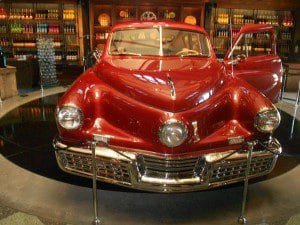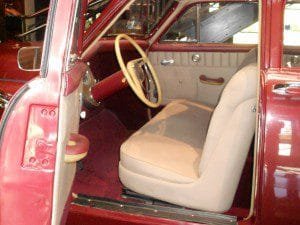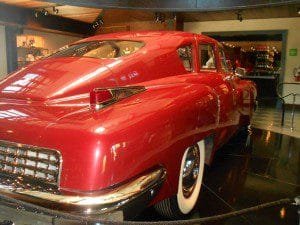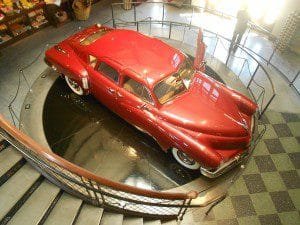The Pontiac Streamliner series of cars were produced from 1942 to 1948 with an interruption during the war years. Probably the most significant difference with the Pontiac Streamliners was that the car used the B-Body rather than the C-Body. The B- Body was both larger and had a fastback style. The vintage car shown here is the 1947 Pontiac.
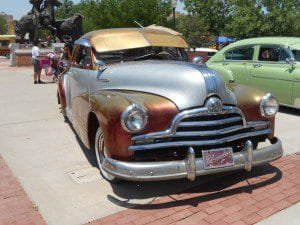
The Streamliner Coupe was first put on the market after the war in September of 1945 which was the 1946 model year.
The car in general was larger than previous models. It was both wider and lower. It was also considered one of the better looking cars of the time and was considered quality built. The Streamliner was also Pontiac’s higher priced series.
Pontiac’s “Silver Streak” styling continued with the 1947 model year. The Silver Streak styling was known for it’s chrome script really had it’s beginnings back in the 1930’s. All the coupes and sedans built in 1947 were fastbacks. The only model with fastback styling was the station wagon. Five bands of chrome were on the hoods. The Interiors for both the sedans and coupes were made with Berwicke beige panels for the dashboard area and windows.
Silver Streak 1946 advertisements of the time pointed out it’s advanced design and engineering along with it’s dependability and extra value offered. In 1948 Pontiac ads highlighted touted a big improvement in a “wonderful” car including General Motor’s Hydo-Drive. The 1948 Streamliner ads highlighted more powerful braking systems that were said to be easier to use in both city and highway driving. Performance was another big issue which Pontiac pointed out owners had been accustomed to with their vehicles.
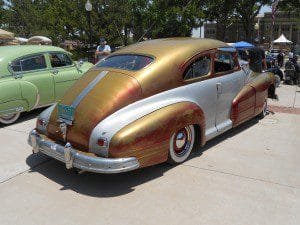
The 1947 Pontiac six cylinder Streamliner production was 42,336 and the production on the eights were 86,300. To give you an idea of the sales increases after World War Two, the last pre war 1942 Streamliner model sold a combined 39,000 cars. The post war 1946 model year saw a total of 92,400 cars sold. The war years obviously created much pent up demand. Specifications for the Streamliner series was a 122 inch wheelbase, a length of 210.3 inches, an average weight of 3,600 pounds, and a price tag of anywhere from $1,000 to $2,500. The six cylinders produced 90 Hp and the eights 103.
Some of the changes seen in the various 1940’s Pontiac Streamliner models are the triple chrome fender grill on the 1946’s, the simpler grill on the 47’s and the nameplate on the top of the grill on the 1948’s. One of the things that made the 1940’s stand out for Pontiac was the sleek design of the Streamliners and the 1947 Pontiac shown here is a fine example. Immediately after the war, most automakers sold all of the 1942 designs that weren’t sold because of the war. This meant not a lot of big changes immediately in design. Pontiac on the other hand went against the grain with the Streamliner Deluxe.
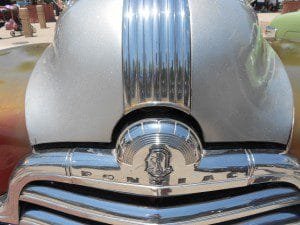
General Motors Pontiac advertisements immediately after the war, like some other automaker’s advertisement, spoke of how they contributed to the war effort building tanks, engines, artillery, etc. They touted how their cars helped get workers to the factories producing war products. Now that the war was over, the advertisements essentially stated that they were back in the automotive business.
Many of these 1940’s era Pontiacs remain great collector cars. One is the 1948 Pontiac Streamliner Woodie Station Wagon. They were the largest on the market at the time and advertised as seating nine people. These Pontiac Woodies are considered quite rare. One reason is that the entire rear body of the 48’s were made of real wood, timber. Beginning with the 1949’s, the rear roof section used steel. In fact, steel was used more and more on these “Woodies” all the way up to 1953. The authentic 1948 model with over 500 genuine wood parts therefore is a real prized find.
Another very classic car from the 1940’s is the highly rare Tucker automobile shown in our article on AutoMuseumOnline. The Tucker automobile and it’s founder, Preston Tucker, is quite a unique story. Also see our article on the milestone car, the 1962 Studebaker Gran Turismo Hawk, the last of the Hawk series.
The Pontiac Division of General Motors Corporation has a fine history. After World War Two you could say they were among the new style leaders among American automobile manufacturers.
(Article and photos copyright AutoMuseumOnline)
